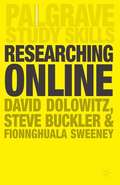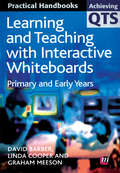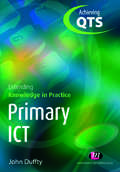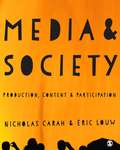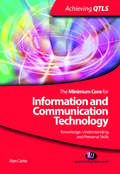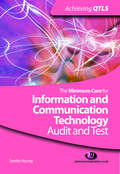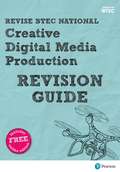- Table View
- List View
Researching Online (PDF)
by David Dolowitz Steve Buckler Fionnghuala Sweeney David P. DolowitzThis book offers a clear and comprehensive introduction to the use of internet technology in research. It provides full accounts of the different ways in which online resources can help with research projects in any area of the social sciences or humanities along with useful hints and tips as to how you can make the internet work for you.
Frontiers In New Media Research (PDF)
by Francis L. F. Lee Louis Leung Jack Linchuan Qiu Donna S. C. ChuThis volume puts together the works of a group of distinguished scholars and active researchers in the field of media and communication studies to reflect upon the past, present, and future of new media research. The chapters examine the implications of new media technologies on everyday life, existing social institutions, and the society at large at various levels of analysis. Macro-level analyses of changing techno-social formation - such as discussions of the rise of surveillance society and the "fifth estate" - are combined with studies on concrete and specific new media phenomena, such as the rise of Pro-Am collaboration and "fan labor" online. In the process, prominent concepts in the field of new media studies, such as social capital, displacement, and convergence, are critically examined, while new theoretical perspectives are proposed and explicated. Reflecting the inter-disciplinary nature of the field of new media studies and communication research in general, the chapters interrogate into the problematic through a range of theoretical and methodological approaches. The book should offer students and researchers who are interested in the social impact of new media both critical reviews of the existing literature and inspirations for developing new research questions.
Learning and Teaching with Interactive Whiteboards: Primary and Early Years (PDF)
by David Barber Linda Cooper Mr Graham MeesonInteractive Whiteboards (IWBs) are becoming increasingly common in schools and early years settings, and it is important for trainees to be equipped with the necessary skills and understanding to use them effectively to enhance learning. This book takes a thematic approach, examining all the key issues required to get the most out of this versatile learning technology. All chapters contain case studies from a range of subject areas and across the key stages, ensuring the text is rooted in the reality of the primary classroom and its curriculum.
Primary ICT: Extending Knowledge in Practice (PDF)
by Mr John DufftyStill the biggest concern for many on initial teacher training courses is the acquisition of subject knowledge and the ability to translate that into effective teaching. This book addresses this - building on the core subject knowledge covered in the Achieving QTS series and relating it to classroom practice. It supports trainees in extending and deepening their knowledge of ICT and demonstrating how to apply it to planning and implementing lessons. Practical and up-to-date teaching examples are used to clearly contextualize subject knowledge. A clear focus on classroom practice helps trainees to build confidence and develop their own teaching strategies.
Confident Coding: Master The Fundamentals Of Code And Supercharge Your Career (PDF)
by Rob PercivalIf you want to master the fundamentals of coding and kick start your career, Confident Coding is the book for you. Everyone has a digital life, but too few truly understand how the software that dominates the world actually works. Coding is one of the most in demand skills on the job market and grasping the basics can advance your creative potential and make you stand out from the crowd. Rob Percival gives you a step-by-step learning guide to HTML, CSS, JavaScript, Python, building iPhone apps, building Android apps and debugging. On reading this book and honing your skills through practice, you will be able to code in each of these languages, build your own website, build your own app and have the confidence to supercharge your employability. Confident Coding provides you with the roadmap you need to enhance your professional life through coding, with insightful and inspirational guidance, including real life success stories, on how to use your new skills. The ability to code can give your CV the edge on the competition, give you greater autonomy and improve your work performance. If you are a self-employed entrepreneur, being able to create your own website or app can grant you valuable freedom and revolutionize your business. If you are an aspiring developer, this book will give you the building blocks to embark on this career path.
Learning Technologies In The Workplace: How To Successfully Implement Learning Technologies In Organizations (PDF)
by Donald H. TaylorKnowledge was once power - difficult to find, slow to transmit and coveted. Now we can access almost the sum total of human information with a swipe of our thumbs. The impact on the knowledge economy has been vast, leaving learning and development (L&D) professionals wondering how to keep pace. Many organizations naturally turn to technology to ensure workplace learning at scale and at speed, but stumble when it comes to successfully deploying and using it. Learning Technologies in the Workplace examines 16 years of learning technology implementations to find the secrets behind the most successful. Examples in the book from the Hershey Company and BP, airlines, tech companies and manufacturers point to four common factors. Successful learning technology teams all have APPA: a clear aim, a people focus, a wide perspective and a pragmatic, can-do attitude. Learning Technologies in the Workplace gives readers practical pointers for each of these four points, helping them implement and use learning technologies well, with particular emphasis on the essential skill of identifying stakeholders and winning their support.
Industry X.0 – Realizing Digital Value in Industrial Sectors
by Eric SchaefferIndustry X. 0 takes an insightful look at the business impact of the Internet of Things movement on the industrial sphere. Eric Schaeffer combines deep analysis with practical strategic guidance, and offers tangible and actionable recommendations on how to realise value in the current digital age. Based on extensive research and insights into the six core competencies that have been identified by Accenture, Industry X. 0 explores critical aspects of the Industrial Internet of Things (IIoT), discussing and defining them in an engaging and accessible manner. These include managing smart data, handling digital product development, skilling up the workforce, mastering innovation, making the most of platforms and ecosystems, and much more. Meticulously researched and clearly explained, Industry X. 0 makes a stringent case for companies to actively shift mind-sets away from products, towards services, value and outcomes. Complemented by a wealth of case studies and real world examples, this book provides invaluable, practical 'how-to' advice for business organizations as they embark on their journeys into the era of the IIoT.
Learning Technologies in the Workplace
by Donald H TaylorKnowledge was once power - difficult to find, slow to transmit and coveted. Now we can access almost the sum total of human information with a swipe of our thumbs. The impact on the knowledge economy has been vast, leaving learning and development (L&D) professionals wondering how to keep pace. Many organizations naturally turn to technology to ensure workplace learning at scale and at speed, but stumble when it comes to successfully deploying and using it. Learning Technologies in the Workplace examines 16 years of learning technology implementations to find the secrets behind the most successful. Examples in the book from the Hershey Company and BP, airlines, tech companies and manufacturers point to four common factors. Successful learning technology teams all have APPA: a clear aim, a people focus, a wide perspective and a pragmatic, can-do attitude. Learning Technologies in the Workplace gives readers practical pointers for each of these four points, helping them implement and use learning technologies well, with particular emphasis on the essential skill of identifying stakeholders and winning their support.
Media and Society: Production, Content and Participation (PDF)
by Eric Louw Nicholas Carah'This is the media and society text that critical scholars have been waiting for'. - Professor Mark Andrejevic, Pomona College This book unpacks the role of the media in social, cultural and political contexts and encourages you to reflect on the power relationships that are formed as a result. Structured around the three cornerstones of media studies; production, content and participation, this is an ideal introduction to your studies in media, culture and society. The book: Evaluates recent developments in media production, industries and platforms brought about the emergence of interactive media technologies. Examines the shifting relationship between media production and consumption instigated by the rise of social and mobile media, recasting consumption as ‘participation’. Explores the construction of texts and meanings via media representations, consumer culture and popular culture, as well as the relationship between politics and public relations. Assesses the debates around the creative and cultural labour involved in meaning-making. Includes a companion website featuring exercise and discussion questions, links to relevant blogs and web material, lists of further reading and free access to key journal articles.
Confident Coding
by Rob PercivalIf you want to master the fundamentals of coding and kick start your career, Confident Coding is the book for you. Everyone has a digital life, but too few truly understand how the software that dominates the world actually works. Coding is one of the most in demand skills on the job market and grasping the basics can advance your creative potential and make you stand out from the crowd. Rob Percival gives you a step-by-step learning guide to HTML, CSS, JavaScript, Python, building iPhone apps, building Android apps and debugging. On reading this book and honing your skills through practice, you will be able to code in each of these languages, build your own website, build your own app and have the confidence to supercharge your employability. Confident Coding provides you with the roadmap you need to enhance your professional life through coding, with insightful and inspirational guidance, including real life success stories, on how to use your new skills. The ability to code can give your CV the edge on the competition, give you greater autonomy and improve your work performance. If you are a self-employed entrepreneur, being able to create your own website or app can grant you valuable freedom and revolutionize your business. If you are an aspiring developer, this book will give you the building blocks to embark on this career path.
The Minimum Core for Information and Communication Technology: Knowledge, Understanding and Personal Skills (PDF)
by Alan ClarkeThe teacher training framework, introduced in September 2007, requires all teachers in the post-16 sector to possess knowledge, understanding and personal skills to at least level 2 in the minimum core for ICT. Coverage and assessment of the minimum core have to be embedded in all Certificate and Diploma courses leading to QTLS and ATLS status. This book is a practical guide to ICT for trainee teachers in the Lifelong Learning Sector. It enables trainee teachers to identify and develop their own ICT skills and to support their students in ICT.
The Minimum Core for Information and Communication Technology: Audit and Test (PDF)
by Sandra MurrayThis book supports trainee teachers in the Lifelong Learning Sector in the assessment of their knowledge of ICT. A self-audit section is included to help trainees understand their level of competence and confidence and will help them identify any gaps in their knowledge and skills. This is followed by exercises and activities to support and enhance learning. The book covers all the content of the LLUK standards for the minimum core for information and communication technology. Coverage and assessment of the core have to be embedded in all Certificate and Diploma courses leading to QTLS and ATLS status.
CT Scanner (UEB uncontracted)
by RnibImage shows a cross section of a circular CT scanner with the patient lying flat on a bed in the centre of the scanner. The view is of the patient with their head to the front. To the top left, within the scanner is rectangle labelled X-ray tube from which an X-ray beam is being emitted across the scanner and through the patient. The circular frame of the scanner is labelled 'Ring of detectors connected to a computer'.
CT Scanner (large print)
by RnibImage shows a cross section of a circular CT scanner with the patient lying flat on a bed in the centre of the scanner. The view is of the patient with their head to the front. To the top left, within the scanner is rectangle labelled X-ray tube from which an X-ray beam is being emitted across the scanner and through the patient. The circular frame of the scanner is labelled 'Ring of detectors connected to a computer'.
CT Scanner (UEB contracted)
by RnibImage shows a cross section of a circular CT scanner with the patient lying flat on a bed in the centre of the scanner. The view is of the patient with their head to the front. To the top left, within the scanner is rectangle labelled X-ray tube from which an X-ray beam is being emitted across the scanner and through the patient. The circular frame of the scanner is labelled 'Ring of detectors connected to a computer'.
Revise BTEC National Creative Digital Media Production Revision Guide (REVISE BTEC Nationals in Creative Digital Media Production)
by Nigel SaundersOur revision resources are the smart choice for those revising for the externally assessed units in Creative Digital Media Production BTEC Nationals from 2017. This book will help you to: • Revise all the essential content and key skills for each unit • Organise your revision with the one-topic-per-page format • Speed up your revision with helpful hints on how to tackle questions and tasks • Track your revision progress with at-a-glance check boxes • Check your understanding with annotated example responses • Practise with revision questions, with answers
Zip Drive and Disk (UEB uncontracted)
by RnibThis page shows images of a Zip disk and a Zip drive. They are separated by a thin vertical line. There is a locator dot shown, which will be at the top left of the page when the image is the right way up. On the left is a top view of a Zip disk and to the right is a drive viewed from the top. Zip disk: This top view of a disk shows a cover at the top of the image. It slides to the left to give access to the magnetic disk inside the casing. There is a label at the bottom for listing the contents of the disk. Zip drive: On the right of the page is an image of the drive seen from the top. At the top of the image is the casing of the drive. Down the page is a clear window with part of a disk visible through it. At the bottom of the page is the remaining portion of the disk with an arrow to the left of it to show the disk being inserted. To the right of the disk are two indicator lights and an eject button. On the right hand edge of the image, at the top and bottom, are two rubber feet to stand the drive on.
Zip Drive and Disk (UEB contracted)
by RnibThis page shows images of a Zip disk and a Zip drive. They are separated by a thin vertical line. There is a locator dot shown, which will be at the top left of the page when the image is the right way up. On the left is a top view of a Zip disk and to the right is a drive viewed from the top. Zip disk: This top view of a disk shows a cover at the top of the image. It slides to the left to give access to the magnetic disk inside the casing. There is a label at the bottom for listing the contents of the disk. Zip drive: On the right of the page is an image of the drive seen from the top. At the top of the image is the casing of the drive. Down the page is a clear window with part of a disk visible through it. At the bottom of the page is the remaining portion of the disk with an arrow to the left of it to show the disk being inserted. To the right of the disk are two indicator lights and an eject button. On the right hand edge of the image, at the top and bottom, are two rubber feet to stand the drive on.
Zip Drive and Disk (large print)
by RnibThis page shows images of a Zip disk and a Zip drive. They are separated by a thin vertical line. There is a locator dot shown, which will be at the top left of the page when the image is the right way up. On the left is a top view of a Zip disk and to the right is a drive viewed from the top. Zip disk: This top view of a disk shows a cover at the top of the image. It slides to the left to give access to the magnetic disk inside the casing. There is a label at the bottom for listing the contents of the disk. Zip drive: On the right of the page is an image of the drive seen from the top. At the top of the image is the casing of the drive. Down the page is a clear window with part of a disk visible through it. At the bottom of the page is the remaining portion of the disk with an arrow to the left of it to show the disk being inserted. To the right of the disk are two indicator lights and an eject button. On the right hand edge of the image, at the top and bottom, are two rubber feet to stand the drive on.
Wide Area Network (tactile)
by RnibThis diagram shows a wide area network. In the centre of the diagram there are 5 nodes connected together. The is a computer connected to a node on the left, and a computer connected to a node on the right.
Virtual Memory (tactile)
by RnibThis diagram shows an example of virtual memory. The parts that are labelled are: page; offset; pages table; +; memory.
Typeface Size and Categories (UEB contracted)
by RnibThis page shows printed characters (letters) in three different type sizes, and two of the main classes of typeface: serif and san-serif (without serifs). There is a locator dot shown, which will be at the top left of the page when the image is the right way up. In the top portion of the page there are three groups of characters increasing in size from 24 point on the left to 72 point on the right. At the bottom left of the page is a capital A with serifs, and on the right another A with no serifs.
Typeface Size and Categories (large print)
by RnibThis page shows printed characters (letters) in three different type sizes, and two of the main classes of typeface: serif and san-serif (without serifs). There is a locator dot shown, which will be at the top left of the page when the image is the right way up. In the top portion of the page there are three groups of characters increasing in size from 24 point on the left to 72 point on the right. At the bottom left of the page is a capital A with serifs, and on the right another A with no serifs.
Typeface Size and Categories (UEB uncontracted)
by RnibThis page shows printed characters (letters) in three different type sizes, and two of the main classes of typeface: serif and san-serif (without serifs). There is a locator dot shown, which will be at the top left of the page when the image is the right way up. In the top portion of the page there are three groups of characters increasing in size from 24 point on the left to 72 point on the right. At the bottom left of the page is a capital A with serifs, and on the right another A with no serifs.
Type Styles (UEB contracted)
by RnibThis page shows printed characters (letters) in two typefaces, Times New Roman and San-serif. Both are presented in regular, italic, bold and bold italic type styles, all in upper and lower case. There is a locator dot shown, which will be at the top left of the page when the image is the right way up. Across the top half of the page is Times New Roman in 72 point size. Across the bottom half of the page is San- serif in 72 point size.
